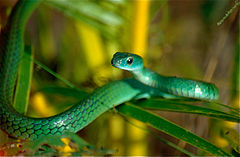Chironius
rodzaj węży z rodziny połozowatych
Chironius – rodzaj węży z podrodziny Colubrinae w rodzinie połozowatych (Colubridae).
| Chironius[1] | |||
| Fitzinger, 1826[2] | |||
 Przedstawiciel rodzaju – Ch. scurrulus | |||
| Systematyka | |||
| Domena | |||
|---|---|---|---|
| Królestwo | |||
| Typ | |||
| Podtyp | |||
| Gromada | |||
| Podgromada | |||
| Rząd | |||
| Podrząd | |||
| Infrarząd | |||
| Nadrodzina |
Colubroidea | ||
| Rodzina | |||
| Podrodzina | |||
| Rodzaj |
Chironius | ||
| Typ nomenklatoryczny | |||
|
Coluber carinatus Linnaeus, 1758 | |||
| Synonimy | |||
|
| |||
| Gatunki | |||
| |||
Zasięg występowania edytuj
Rodzaj obejmuje gatunki występujące w Hondurasie, Salwadorze, Nikaragui, Kostaryce, Panamie, na Saint Vincent, Kolumbii, Peru, Ekwadorze, Wenezueli, Gujanie, Surinamie, Gujanie Francuskiej, Brazylii, Boliwii, Paragwaju, Urugwaju i Argentynie[9].
Systematyka edytuj
Etymologia edytuj
- Chironius: w mitologii greckiej Chiron (gr. Χείρων Cheírōn, łac. Chiron), był najmądrzejszym i najbardziej cywilizowanym z centaurów[10].
- Erpetodryas (Herpetodrys, Herpetodryas): gr. ἑρπετον herpeton „gad”[11]; δρυας druas, δρυαδος druados „driady, nimfy drzewne”, od δρυς drus, δρυος druos „dąb”[12]. Gatunek typowy: Coluber carinatus Linnaeus, 1758.
- Macrops: gr. μακρος makros „długi”; ωψ ōps, ωπος ōpos „wygląd”[5]. Gatunek typowy: Coluber saturninus Linnaeus, 1758 (= Coluber fuscus Linnaeus, 1758).
- Hylophis: gr. ὑλη hulē „teren lesisty, las”[13]; οφις ophis, οφεως opheōs „wąż”[14]. Gatunek typowy: Coluber laevicollis Wied-Neuwied, 1824.
- Phyllosira: gr. φυλλον phullon „liść”[15]; σειρα seira „ogon węża”[16]. Gatunek typowy: Phyllosira flavescens Cope, 1862 (= Erpetodryas quadricarinatus Boie, 1827).
Podział systematyczny edytuj
Do rodzaju należą następujące gatunki[9]:
- Chironius bicarinatus
- Chironius brazili
- Chironius carinatus
- Chironius challenger
- Chironius diamantina
- Chironius exoletus
- Chironius flavolineatus
- Chironius flavopictus
- Chironius foveatus
- Chironius fuscus
- Chironius grandisquamis
- Chironius laevicollis
- Chironius laurenti
- Chironius leucometapus
- Chironius maculoventris
- Chironius monticola – sipo górski[17]
- Chironius multiventris
- Chironius quadricarinatus
- Chironius scurrulus
- Chironius septentrionalis
- Chironius spixii
- Chironius vincenti
Przypisy edytuj
- ↑ Chironius, [w:] Integrated Taxonomic Information System (ang.).
- ↑ L.J.F.J. Fitzinger: Neue classification der reptilien nach ihren natürlichen verwandtschaften: nebst einer verwandtschafts-tafel und einem verzeichnisse der reptilien-sammlung des K. K. zoologischen museum’s zu Wien. Wien: J. G. Heubner, 1826, s. 29, 60. (niem.).
- ↑ H. Boie. Les nouveaux genres. „Bulletin des Sciences Naturelles et de Géologie”. 9, s. 237, 237. (fr.).
- ↑ Wagler 1830 ↓, s. 180.
- ↑ a b Wagler 1830 ↓, s. 182.
- ↑ H. Schlegel: Essai sur la physionomie des serpens. Cz. 1. Amsterdam: Schonekat, 1837, s. 150. (fr.).
- ↑ L.J.F.J. Fitzinger: Systema reptilium. Fasciculus primus, Amblyglossae. Vindobonae: Braumüller et Seidel, 1843, s. 26. (łac.).
- ↑ E.D. Cope. Catalogues of the reptiles obtained during the Explorations of the Parana, Paraguay, Vermejo and Uruguay Rivers, by Capt. Thos. J. Page, U.S.N.; and of those procured by Lieut. N. Michler, U.S. Top. Eng., Commander of the Expedition conducting the survey of the Atrato River. „Proceedings of the Academy of Natural Sciences of Philadelphia”. 14, s. 149, 1862. (ang.).
- ↑ a b P. Uetz & J. Hallermann: Genus: Chironius. The Reptile Database. [dostęp 2019-03-19]. (ang.).
- ↑ Jaeger 1944 ↓, s. 48.
- ↑ Jaeger 1944 ↓, s. 104.
- ↑ Jaeger 1944 ↓, s. 76.
- ↑ Jaeger 1944 ↓, s. 106.
- ↑ Jaeger 1944 ↓, s. 154.
- ↑ Jaeger 1944 ↓, s. 174.
- ↑ Jaeger 1944 ↓, s. 209.
- ↑ Praca zbiorowa: Zwierzęta: encyklopedia ilustrowana. Warszawa: Wydawnictwo Naukowe PWN, 2005, s. 408. ISBN 83-01-14344-4.
Bibliografia edytuj
- J.G. Wagler: Natürliches System der Amphibien, mit vorangehender Classification der Säugethiere und Vögel. Ein Beitrag zur vergleichenden Zoologie. München, Stuttgart und Tübingen: In der J.G. Cotta’scchen Buchhandlung, 1830, s. 1–354. (niem.).
- Edmund C. Jaeger, Source-book of biological names and terms, wyd. 1, Springfield: Charles C. Thomas, 1944, s. 1–256, OCLC 637083062 (ang.).